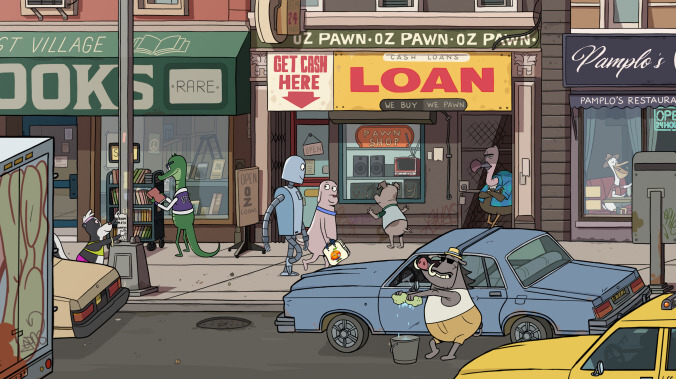Robot Dreams animates New York City hustle without saying a word
Pablo Berger's Oscar-nominated animated daydream is an episodic tale of friendship deferred
Film Reviews Robot
Photo: Neon
Eclectic Spanish filmmaker Pablo Berger has made silent movies before, but never one quite like Robot Dreams. A New York tourism advert for anyone who thinks WALL-E sold out to Big Talkie after breaking its opening vow of silence, Robot Dreams communicates the aches, pains, and joys of a friendship deferred without a word of dialogue. Though its minimally designed characters don’t speak, the nuts and bolts of this Robot’s dreams complicate Berger’s tour of New York, filled with authentic urban soundscapes and a population of anthropomorphic animals and their robot companions.
Opening on the Queensboro Bridge under deep blue dusk, Robot Dreams introduces us to Dog, a lonely mutt living in the ’80s and spending another night with Atari and frozen mac and cheese. After beating himself in Pong (again), Dog finally acknowledges the loneliness of beating yourself at Pong (again). So, at the behest of a perfectly timed infomercial, he orders a new friend: Robot. With a flick of the neck, Robot boots to life like a Reagan-era PC loading DOS, and suddenly, Dog’s life has a purpose.
Dog and Robot share a brief relationship. After a few weeks of roller dancing to Earth, Wind & Fire’s “September” in Central Park, they take an ill-fated beach day, wherein Robot rusts in the sand and remains trapped on the dunes. Much of the film’s runtime is spread across Robot and Dog’s year-long separation as Dog mourns the loss of his friend and Robot awaits rescue.
Robot Dreams loves New York. Not just the people and pizza—though there’s plenty of that—but the energy it generates, the movies it inspires, and the challenges it creates. When Robot first hits the East Village streets, sticking out like a sore Tootsie (or maybe a Midnight Cowboy), his arched dome standing tall among the crowds, it’s immediate culture clash. He waves to the young punks blaring Reagan Youth on the streets and receives a friendly flip of the bird in return. Robot doesn’t know enough to take offense, nor was it meant. As a great man once said, “Being miserable and treating people like dirt is every New Yorker’s god-given right.”
Robot Dreams’ strength is in Robot and Dog, who resemble animated shadows of Abbott and Costello or Laurel and Hardy. With those archetypes in mind, Berger highlights their differences for maximum communication. Dog is pragmatic and careful, aware of the consequences of social infractions, and pays the price for them. Robot is more open-minded and ready to greet each new adventure with a welcome smile and wave. But in their separation, they find connecting with those around them difficult.
The alchemy of animation is that Berger’s team creates something more real than reality through illustration. Robot Dreams captures the complex essence of living in New York, a city that offers its residents a world of experience if they can get there. Berger’s New York mirrors the real, with sharp divisions between boroughs, sojourns to the state’s forests, and the bureaucracy that walls it all in. Dog’s attempts to free his Robot from the NYC Parks Department are denied, leaving the latter stuck behind a chain fence and, later, behind bars. Like actual New Yorkers separated by subway lines and area codes, Robot is so close yet so far away.
The title isn’t false advertising: As Robot waits, he dreams. Berger slips into his characters’ subconscious, taking detours into their desires and channeling them into metaphorical vignettes that obscure the world around them. Robot dreams of beach dwellers’ kindness and awakes to someone hacking off its legs. The Big Apple has rarely been rendered so realistically.
Where Berger’s silent Snow White Blancanieves sought to mimic the style of silent European cinema of the early 20th century, Robot Dreams mimics its source material, Sara Varon’s 2007 comic. Each frame resembles a panel that relies on color and perspective to create a flat world of depth and detail. The simple designs of Berger’s leads create a welcoming contrast to the bustling city around them, a division matched by the dream logic of a film that abruptly dives into the psyches of its two main characters. Like fellow anthropomorphic urban satire BoJack Horseman, Robot Dreams feels real and surreal, familiar and bizarre, resulting in unexpected authenticity.
With Robot Dreams, Pablo Berger has crafted an aesthetically gentle but emotionally hardened New York City. Operating under the belief that there is little one can control in a city of that size, Berger allows his film to take flights of fancy that loop around back to companionship. How can a city so filled with people feel so lonely? Without uttering a word, Robot Dreams has an answer.